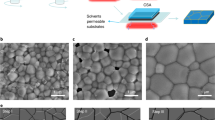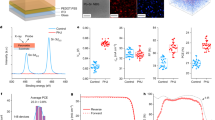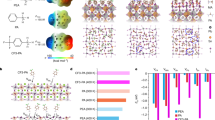Abstract
Perovskite solar cells (PSCs) comprise a solid perovskite absorber sandwiched between several layers of different charge-selective materials, ensuring unidirectional current flow and high voltage output of the devices1,2. A ‘buffer material’ between the electron-selective layer and the metal electrode in p-type/intrinsic/n-type (p-i-n) PSCs (also known as inverted PSCs) enables electrons to flow from the electron-selective layer to the electrode3,4,5. Furthermore, it acts as a barrier inhibiting the inter-diffusion of harmful species into or degradation products out of the perovskite absorber6,7,8. Thus far, evaporable organic molecules9,10 and atomic-layer-deposited metal oxides11,12 have been successful, but each has specific imperfections. Here we report a chemically stable and multifunctional buffer material, ytterbium oxide (YbOx), for p-i-n PSCs by scalable thermal evaporation deposition. We used this YbOx buffer in the p-i-n PSCs with a narrow-bandgap perovskite absorber, yielding a certified power conversion efficiency of more than 25%. We also demonstrate the broad applicability of YbOx in enabling highly efficient PSCs from various types of perovskite absorber layer, delivering state-of-the-art efficiencies of 20.1% for the wide-bandgap perovskite absorber and 22.1% for the mid-bandgap perovskite absorber, respectively. Moreover, when subjected to ISOS-L-3 accelerated ageing, encapsulated devices with YbOx exhibit markedly enhanced device stability.
This is a preview of subscription content, access via your institution
Access options
Access Nature and 54 other Nature Portfolio journals
Get Nature+, our best-value online-access subscription
$29.99 / 30 days
cancel any time
Subscribe to this journal
Receive 51 print issues and online access
$199.00 per year
only $3.90 per issue
Buy this article
- Purchase on Springer Link
- Instant access to full article PDF
Prices may be subject to local taxes which are calculated during checkout




Similar content being viewed by others
Data availability
All data are available in the main text or the Supplementary Information and are also available from the corresponding authors on reasonable request.
References
Jena, A. K., Kulkarni, A. & Miyasaka, T. Halide perovskite photovoltaics: background, status, and future prospects. Chem. Rev. 119, 3036–3103 (2019).
Luo, D., Su, R., Zhang, W., Gong, Q. & Zhu, R. Minimizing non-radiative recombination losses in perovskite solar cells. Nat. Rev. Mater. 5, 44–60 (2019).
Jiang, Q. et al. Surface reaction for efficient and stable inverted perovskite solar cells. Nature 611, 278–283 (2022).
Tan, Q. et al. Inverted perovskite solar cells using dimethylacridine-based dopants. Nature 620, 545–551 (2023).
Peng, W. et al. Reducing nonradiative recombination in perovskite solar cells with a porous insulator contact. Science 379, 683–690 (2023).
Wu, S. et al. 2D metal-organic framework for stable perovskite solar cells with minimized lead leakage. Nat. Nanotechnol. 15, 934–940 (2020).
Wu, S. et al. A chemically inert bismuth interlayer enhances long-term stability of inverted perovskite solar cells. Nat. Commun. 10, 1161 (2019).
Zhang, S. et al. Barrier designs in perovskite solar cells for long-term stability. Adv. Energy Mater. 10, 2001610 (2020).
Luo, D. et al. Enhanced photovoltage for inverted planar heterojunction perovskite solar cells. Science 360, 1442–1446 (2018).
Fei, C. et al. Lead-chelating hole-transport layers for efficient and stable perovskite minimodules. Science 380, 823–829 (2023).
Li, C. et al. Rational design of Lewis base molecules for stable and efficient inverted perovskite solar cells. Science 379, 690–694 (2023).
Azmi, R. et al. Damp heat–stable perovskite solar cells with tailored-dimensionality 2D/3D heterojunctions. Science 376, 73–77 (2022).
Zhang, S. et al. Minimizing buried interfacial defects for efficient inverted perovskite solar cells. Science 380, 404–409 (2023).
Park, S. M. et al. Low-loss contacts on textured substrates for inverted perovskite solar cells. Nature https://doi.org/10.1038/s41586-023-06745-7 (2023).
Liang, Z. et al. Out-of-plane cations homogenise perovskite composition for solar cells. Nature https://doi.org/10.1038/s41586-023-06784-0 (2023).
Li, B. & Zhang, W. Improving the stability of inverted perovskite solar cells towards commercialization. Commun. Mater. 3, 65 (2022).
Duan, L. et al. Stability challenges for the commercialization of perovskite–silicon tandem solar cells. Nat. Rev. Mater. 8, 261–281 (2023).
Zhu, H. et al. Long-term operating stability in perovskite photovoltaics. Nat. Rev. Mater. 8, 569–586 (2023).
Macpherson, S. et al. Local nanoscale phase impurities are degradation sites in halide perovskites. Nature 607, 294–300 (2022).
Guo, R. et al. Degradation mechanisms of perovskite solar cells under vacuum and one atmosphere of nitrogen. Nat. Energy 6, 977–986 (2021).
Nazir, G. et al. Stabilization of perovskite solar cells: Recent developments and future perspectives. Adv. Mater. 34, 2204380 (2022).
Bai, S. et al. Planar perovskite solar cells with long-term stability using ionic liquid additives. Nature 571, 245–250 (2019).
Hu, J. T. et al. Tracking the evolution of materials and interfaces in perovskite solar cells under an electric field. Commun. Mater. 3, 39 (2022).
Li, J., Dong, Q., Li, N. & Wang, L. Direct evidence of ion diffusion for the silver-electrode-induced thermal degradation of inverted perovskite solar cells. Adv. Energy Mater. 7, 1602922 (2017).
Domanski, K. et al. Not all that glitters is gold: metal-migration-induced degradation in perovskite solar cells. ACS Nano 10, 6306–6314 (2016).
Li, X. et al. Constructing heterojunctions by surface sulfidation for efficient inverted perovskite solar cells. Science 375, 434–437 (2022).
Li, X. et al. High-efficiency and durable inverted perovskite solar cells with thermally-induced phase-change electron extraction layer. Adv. Energy Mater. 11, 2102844 (2021).
Wu, M.-H. et al. Low-power-consumption and long-lifetime OLED with a high Tg n-type organic transport material. Proc. SPIE 5519, 263 (2004).
Khenkin, M. V. et al. Consensus statement for stability assessment and reporting for perovskite photovoltaics based on isos procedures. Nat. Energy 5, 35–49 (2020).
Greiner, M. T. et al. Universal energy-level alignment of molecules on metal oxides. Nat. Mater. 11, 76–81 (2012).
Ohno, Y. XPS studies of the intermediate valence state of Yb in (YbS)1.25CrS2. J. Electron. Spectros. Relat. Phenomena 165, 1–4 (2008).
Lang, W., Padalia, B., Watson, L. & Fabian, D. Reinvestigation of the core levels of pure and oxidised ytterbium and lutetium. J. Electron. Spectrosc. Relat. Phenomena 7, 357–358 (1975).
He, Y. et al. Amorphizing noble metal chalcogenide catalysts at the single-layer limit towards hydrogen production. Nat. Catal. 5, 212–221 (2022).
Chen, N., Wang, D., Hu, J., Guan, L. & Lu, Z.-H. Measuring energy gaps of organic semiconductors by electron energy loss spectroscopies. Phys. Status Solidi B 259, 2100459 (2021).
Chen, P. et al. Refining perovskite heterojunctions for effective light-emitting solar cells. Adv. Mater. 35, 2208178 (2023).
Greiner, M. T., Chai, L., Helander, M. G., Tang, W.-M. & Lu, Z.-H. Metal/metal-oxide interfaces: How metal contacts affect the work function and band structure of MoO3. Adv. Funct. Mater. 23, 215–226 (2013).
Mott, N. Electrons in glass. Nature 257, 15–18 (1975).
Oliver, R. D. J. et al. Understanding and suppressing non-radiative losses in methylammonium-free wide-bandgap perovskite solar cells. Energy Environ. Sci. 15, 714–726 (2022).
Tong, J. et al. Wide-bandgap metal halide perovskites for tandem solar cells. ACS Energy Lett. 6, 232–248 (2020).
Ganose, A. M., Scanlon, D. O., Walsh, A. & Hoye, R. L. Z. The defect challenge of wide-bandgap semiconductors for photovoltaics and beyond. Nat. Commun. 13, 4715 (2022).
Tremblay, M.-H. et al. Benzocyclobutene polymer as an additive for a benzocyclobutene-fullerene: Application in stable p-i-n perovskite solar cells. J. Mater. Chem. A 9, 9347–9353 (2021).
Acknowledgements
This work was financially supported by the Natural Science Foundation of China (52325310 and 52203208), the Beijing Natural Science Foundation (JQ21005), the National Key R&D Program of China (2021YFB3800100 and 2021YFB3800101), the Science and Technology Project of Southwest Joint Graduate School of Yunnan Province (research on the key problems of PSCs for applications), the open research fund of Songshan Lake Materials Laboratory (2022SLABFK07), CAS Pioneer Hundred Talents Program B (E2XBRD1001), the China Postdoctoral Science Foundation (2023TQ0009 and 2023M740116) and the R&D Fruit Fund (20210001). This work was also sponsored by the Beijing Nova Program (contract nos. 20220484148 and 20230484480). H.J.S. acknowledges funding from the Engineering and Physical Science Council (EPSRC) (grant no. EP/S004947/1). Y.X. acknowledges Moritz Riede of Oxford University for his supervision in general. Y.X. acknowledges the China Oxford Scholarship Fund. We also thank beamlines BL19U1, BL17B1 and BL14B1 at the SSRF for providing the beamtime and the User Experiment Assist System of the SSRF for their help.
Author information
Authors and Affiliations
Contributions
D.L., Z.-H.L., P. Chen, Y.X. and R.Z. conceived the idea and designed the experiments. P. Chen, Y.X., S.L., X.J. and T.H. fabricated the PSCs and characterized the photovoltaic performances. P. Chen and M.Y. performed the electroluminescence tests. Y.X., P.K. and P. Caprioglio contributed to the analysis of electroluminescence results. X.L. conducted the EQE measurements. J.H., J.W., Y.S. and P.T. conducted the TEM and energy disperse X-ray tests. J.H. and N.C. performed REELS, UPS and XPS measurements. J.H., N.C., D.W., D.L., R.S. and Z.-H.L. contributed to analysing the REELS, UPS and XPS results. N.C. and Z-H.L. contributed to the analysis of charge transport mechanisms. J.H., P.C., Y.X. and Q.L. conducted the scanning electron microscope measurements. S.L. and L.Z. helped perform the grazing-incidence wide-angle X-ray scattering measurements. P.C. and Y.X. measured the UV–Vis light absorption. C.-H.H., Y.-W.Y. and J.-J.S. performed the TOF-SIMS measurements. P.C., Y.X. and Q.Z. performed the time-resolved photoluminescence test and did data analysis. H.Y., Y.X. and P.C. conducted the stability test. D.L., Q.G., Z.-H.L., H.J.S. and R.Z. directed and supervised the project. P.C. and Y.X. wrote the first draft of the paper. D.L., Q.G., Z.-H.L., H.J.S. and R.Z. revised the paper. All authors analysed their data and reviewed and commented on the paper.
Corresponding authors
Ethics declarations
Competing interests
Henry J. Snaith is the founder and Chief Scientific Officer of Oxford Photovoltaics, a company commercializing perovskite photovoltaics.
Peer review
Peer review information
Nature thanks Mingkui Wang and the other, anonymous, reviewer(s) for their contribution to the peer review of this work.
Additional information
Publisher’s note Springer Nature remains neutral with regard to jurisdictional claims in published maps and institutional affiliations.
Extended data figures and tables
Extended Data Fig. 1 Overview of buffer layers.
a, Schematic illustration of the functions of an ideal buffer layer between the electron-selective layer (ESL) and the metal electrode, showing suppression of the harmful species movement and the non-radiative recombination. b, Standard molar Gibbs free energy (ΔfG) of formation at 298.15 K in kJ mol–1 of representative metal oxides including ZnO, SnO2, ZnSnO4, TiO2, Cr2O3, and Yb2O3. c, Schematic illustration of the thermal evaporation deposition process of the metal Yb.
Extended Data Fig. 2 XPS characterizations.
a, Photograph of 1.5 nm YbOx film deposited on a large-scale ITO substrate (100 cm2) by a scalable thermal evaporation approach. The areas at the corner of the sample highlighted by the dotted box were used to conduct the XPS measurements. b, Yb 4d XPS spectra corresponding to the highlighted areas in (a). The XPS data show that YbOx on an 100-cm2 substrate can be formed when upscaling in the device fabrication chamber with a base pressure of 10−4 Pa.
Extended Data Fig. 3 XPS measurements and photographs of Yb bulk and YbOx surface.
a, Yb 4d XPS spectrum of the Yb bulk with 2400 s Ar ion etching. Photographs of the pristine Yb bulk with a naturally oxidized YbOx surface (b) and the polished Yb bulk (c) in ambient air. The colour change indicates that the refreshed metal Yb surface would quickly react with oxygen upon oxygen exposure, forming YbOx on the surface.
Extended Data Fig. 4 The oxidization process of Yb.
a, Yb 4d XPS spectrum of an as-prepared ITO/YbOx (1.5 nm) film. The sample was immediately transferred from the physical vapour deposition system to the XPS chamber by the vacuum transfer module without exposure to the air. b, Yb 4d XPS spectra of a clean Yb0 surface spontaneously oxidized in the UHV XPS chamber. L represents Langmuir. c, The YbOx thickness and Yb3+/Yb0 ratios as a function of the exposure dose. d-i, Yb 4d XPS spectra with increased exposure dose.
Extended Data Fig. 5 Transmission electron microscopy (TEM) measurements.
a, b, TEM images of YbOx directly deposited on the carbon-supported copper (50 and 20 nm). c, The typical fast Fourier transform (FFT) spectrum (30 × 30 nm2 area) indicates the amorphous crystal structure of YbOx.
Extended Data Fig. 6 2D grazing incidence wide-angle X-ray scattering (GIWAXS) measurements.
The 2D GIWAXS patterns at an incidence angle of 1.0° for YbOx films prepared on different substrates including silicon (a), glass (b), and ITO-coated glass (c), respectively. The thickness of the deposited YbOx film for this measurement is 10 nm. d, The 2D GIWAXS pattern of the pristine ITO-coated glass.
Extended Data Fig. 7 Gap states in the YbOx film and charge-carrier transport measurements.
a, Yb 4d XPS spectra of the YbOx film with a thickness of 40 nm. b, Valence band spectra of YbOx. There exists a considerable density of gap states below the Fermi level. c, Current density−voltage characteristics of the ITO/[YbOx (2 nm)]20/Cu over temperature ranged from 120 K to 300 K. Note that the 40 nm YbOx deposition is completed by evaporating 20 alternative layers. d, The plot of conductivity against temperature. The conductivity is calculated at 26 mA cm−2, where the injected current is equal to the short-circuit current of a narrow-bandgap PSC under 1-sun illumination. Note that the pre-factor σ0 = (2.22 ± 0.47) × 10−3 S m−1, and the characteristic parameter B = 10.33 ± 0.81.
Extended Data Fig. 8 Charge-carrier transport measurements.
a, Current density−voltage characteristics of the device with a configuration of ITO/[YbOx (5 nm)/Cu (1 nm)]20/Cu over temperature ranged from 110 K to 290 K. b, The plot of conductivity against temperature.
Extended Data Fig. 9 Time-of-flight secondary ion mass spectrometry (TOF-SIMS) measurements.
TOF-SIMS depth profiles of the BCP- or YbOx-based PSCs with and without ageing. a, c, Control (with the BCP buffer layer) and target device (with the YbOx buffer layer), respectively. b, d, TOF-SIMS profiles of both control and target devices after ageing at 85 °C for 200 h in the N2 atmosphere, respectively. The highlighted secondary ion distribution: 1: Cs+; 2: Rb+; 3: Cu+, 4: I+; 5: Br+.
Supplementary information
Supplementary Information
This file contains Supplementary Notes 1–6, Supplementary Figs. 1–19, Supplementary Tables 1–8 and Supplementary References.
Rights and permissions
Springer Nature or its licensor (e.g. a society or other partner) holds exclusive rights to this article under a publishing agreement with the author(s) or other rightsholder(s); author self-archiving of the accepted manuscript version of this article is solely governed by the terms of such publishing agreement and applicable law.
About this article
Cite this article
Chen, P., Xiao, Y., Hu, J. et al. Multifunctional ytterbium oxide buffer for perovskite solar cells. Nature 625, 516–522 (2024). https://doi.org/10.1038/s41586-023-06892-x
Received:
Accepted:
Published:
Issue Date:
DOI: https://doi.org/10.1038/s41586-023-06892-x
This article is cited by
-
Stable, efficient inverted perovskite solar cells enabled by the multifunctional ytterbium oxide buffer
Science China Chemistry (2024)
-
Superior efficiency and stability of YbOx-enhanced perovskite solar cells
Science China Materials (2024)
Comments
By submitting a comment you agree to abide by our Terms and Community Guidelines. If you find something abusive or that does not comply with our terms or guidelines please flag it as inappropriate.



